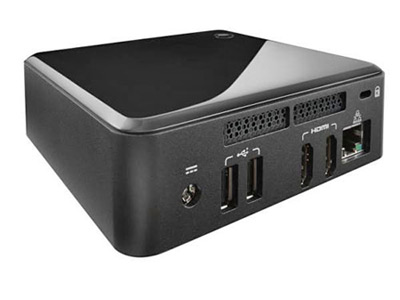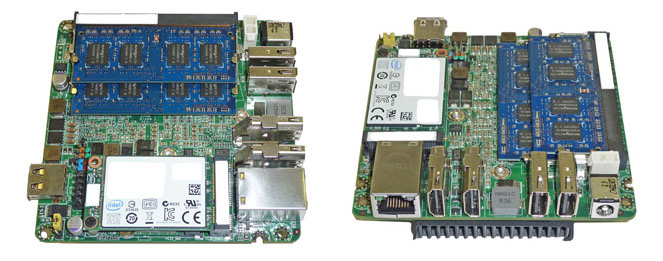Our Aim
To provide you with an overview on New And existing technologies, hopefully helping you understand the changes in the technology. Together with the overviews we hope to bring topical issues to light from a series of independent reviewers saving you the time And hassle of fact finding over the web.
We will over time provide you with quality content which you can browse and subscribe to at your leisure.
TekSpek 's
NUC PCs
Date issued:
A new approach
Extensive market research conducted throughout this year unequivocally shows that worldwide sales of notebook-type PCs have overtaken those of traditional desktop computers. Consumer demand for portable computers, such as the Apple iPad and various Google Android-powered tablets, continues at the expense of desktop PCs, most industry experts agree, so companies such as Intel and AMD, who clearly have a vested interest in the success of regular computers, need to think of new ways to reignite interest in this declining segment of the market.
Chip giant Intel produces the microprocessors - or brains - used in approximately 80 per cent of PCs. The firm acutely understands that desktop computers need to be made more appealing if they're to be lifted from the malaise affecting the industry. To this end, Intel has released a new range of small-form-factor PCs that are known as the Next Unit of Computing (NUC).
NUC PCs are powered by low-voltage Intel Core i3 and Core i5 processors housed on a 10cm x 10cm motherboard. The entire system is enclosed in a tiny case. Smaller than a paperback book but more than potent enough for common tasks such as emailing, high-def video playback and transcoding thanks to excellent CPU performance, NUC also possesses solid gaming credentials from the baked-in Intel HD 4000 Graphics. By aiming to do so much in so little space, then, NUC computers offer an interesting alternative to the larger boxes populating the desktop sector.

Here's a standard NUC chassis, which is barely any larger than the underlying PCB and fits easily into one hand. Construction is robust and, sensibly, Intel provisions for VESA mounts that enable a NUC to be connected to the back of a monitor.
Judge me by my size, do you?

Take away the top and the beating heart of the NUC is the integrated PCB, shown above. In this particular case, it has a pre-soldered, heatsink-covered Intel 'Ivy Bridge' Core i3-3217U processor sat on top of an Intel QS77 chipset. The current physical implementation requires both CPU and core-logic sockets on the motherboard, taking up valuable room. Intel's next-generation 'Haswell' architecture is to integrate the core-logic into the chip itself, providing the means by which to design an even-smaller NUC. Such NUCs are likely to be available early next year.
Coming back to the present, note that the CPU is cooled by a 40mm fan; the unit is not silent. Careful component positioning enables Intel to miniaturise the motherboard down to an impressively-small footprint. At the time of writing, four NUC PCs are available - the wonderfully-named DCCP847DYE (Intel Celeron 847) DC3217IYE, DC3217BY (Intel Core i3-3217U), and DC53427HYE (Intel Core i5-3427U).
In terms of standard interfaces, the DC3217IYE NUC carries up to five USB 2.0 ports - though only three are plumbed out externally on the chassis - two HDMI outputs for dual-display computing; Gigabit Ethernet; a half-height mini PCIe slot; a full-height mini PCIe slot, and space for two DDR3 SODIMM modules. The larger mini PCIe slot accepts solid-state drives presented in an mSATA form factor, while the smaller slot can be populated with a WiFi card for wireless networking.
Meanwhile, the DC3217BY NUC is different insofar as one of the HDMI outputs is substituted for a new-fangled Thunderbolt port. Common to both variants, the ever-so-small size of the NUC means that power is fed through an external brick-type adapter. The best DC53427HYE version includes HDMI, two mini-DisplayPort connectors and, unlike the others, a single USB 3.0 port.
Intel is set to provide the four NUC flavours as barebones units comprising of the PCB - with integrated processor - chassis and external power supply. Everything else is extra, meaning that a fully-built system will still require the user to purchase memory, WiFi card(s) and storage, at the very least.
Barebones NUCs retail from £150, resulting in a complete system build for around £300. This outlay provides a small, capable system that's primed for everyday tasks. There's obviously limited upgradeability potential by dint of its size, but it's a sacrifice worth paying for users who value form factor over all-out power.
Smaller is better?
Intel realises that it must take the lead in invigorating the desktop PC industry. A first step to achieving this is through the release of a small-form-factor system known as the NUC. Tapping into the CPU, graphics, and outputs goodness of a latest-generation Celeron, Core i3 and Core i5 processors, the NUC can be thought of as possessing the qualities of a mainstream laptop, albeit without a display as standard.
The chip giant has commented that these NUCs are the first of many, with subsequent models using a number of different specifications, ranging from even lower-power offerings to genuinely performance-based NUCs harnessing potent Haswell chips. It's too early to tell whether Intel's small-form-factor initiative has the necessary appeal to succeed, but it's heartening to see new approaches to reinvigorate the desktop PC market.
Scan Computers is a premier Intel partner and is stocking the Intel Next Unit of Computing. Please click here for more details.